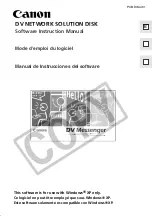
Chapter 14: Quality of Service
168
Section II: Advanced Operations
To use the QoS tool set to configure a DiffServ domain:
1. As packets come into the domain at edge switches, replace their
DSCP value, if required.
Classify the packets according to the required characteristics. For
available options, see Chapter 11, “Classifiers” on page 125.
Assign the classifiers to flow groups and the flow groups to traffic
classes, with a different traffic class for each DiffServ code point
grouping within the DiffServ domain.
Give each traffic class the priority and/or bandwidth limiting
controls that are required for that type of packet within this part of
the domain.
Assign a DSCP value to each traffic class, to be written into the
TOS field of the packet header.
2. On switches and routers within the DiffServ domain, classify packets
according to the DSCP values that were assigned to traffic classes on
the edge switches.
Assign the classifiers to flow groups and the flow groups to traffic
classes, with a different traffic class for each DiffServ code point
grouping within the DiffServ domain.
Give each traffic class the priority and/or bandwidth limiting
controls that are required for that type of packet within this part of
the domain. These QoS controls need not be the same for each
switch.
3. As packets leave the DiffServ domain, classify them according to the
DSCP values.
Assign the classifiers to flow groups and the flow groups to traffic
classes, with a different traffic class for each DiffServ code point
grouping within the DiffServ domain.
Give each traffic class the priority and/or bandwidth limiting
controls required for transmission of that type of packet to its next
destination, in accordance with any Service Level Agreement
(SLA) with the providers of that destination.
If necessary, assign a different DSCP value to each traffic class, to
be written into the TOS field of the packet header, to match the
DSCP or TOS priority values of the destination network.
Summary of Contents for AT-S63
Page 14: ...Figures 14 ...
Page 18: ...Tables 18 ...
Page 28: ...28 Section I Basic Operations ...
Page 58: ...Chapter 1 Overview 58 ...
Page 76: ...Chapter 2 AT 9400Ts Stacks 76 Section I Basic Operations ...
Page 96: ...Chapter 5 MAC Address Table 96 Section I Basic Operations ...
Page 114: ...Chapter 8 Port Mirror 114 Section I Basic Operations ...
Page 116: ...116 Section II Advanced Operations ...
Page 146: ...Chapter 12 Access Control Lists 146 Section II Advanced Operations ...
Page 176: ...Chapter 14 Quality of Service 176 Section II Advanced Operations ...
Page 196: ...196 Section III Snooping Protocols ...
Page 204: ...Chapter 18 Multicast Listener Discovery Snooping 204 Section III Snooping Protocols ...
Page 216: ...Chapter 20 Ethernet Protection Switching Ring Snooping 216 Section III Snooping Protocols ...
Page 218: ...218 Section IV SNMPv3 ...
Page 234: ...234 Section V Spanning Tree Protocols ...
Page 268: ...268 Section VI Virtual LANs ...
Page 306: ...Chapter 27 Protected Ports VLANs 306 Section VI Virtual LANs ...
Page 320: ...320 Section VII Internet Protocol Routing ...
Page 360: ...Chapter 30 BOOTP Relay Agent 360 Section VII Routing ...
Page 370: ...Chapter 31 Virtual Router Redundancy Protocol 370 Section VII Routing ...
Page 372: ...372 Section VIII Port Security ...
Page 402: ...Chapter 33 802 1x Port based Network Access Control 402 Section VIII Port Security ...
Page 404: ...404 Section IX Management Security ...
Page 436: ...Chapter 36 PKI Certificates and SSL 436 Section IX Management Security ...
Page 454: ...Chapter 38 TACACS and RADIUS Protocols 454 Section IX Management Security ...
Page 462: ...Chapter 39 Management Access Control List 462 Section IX Management Security ...
Page 532: ...Appendix D MIB Objects 532 ...
















































